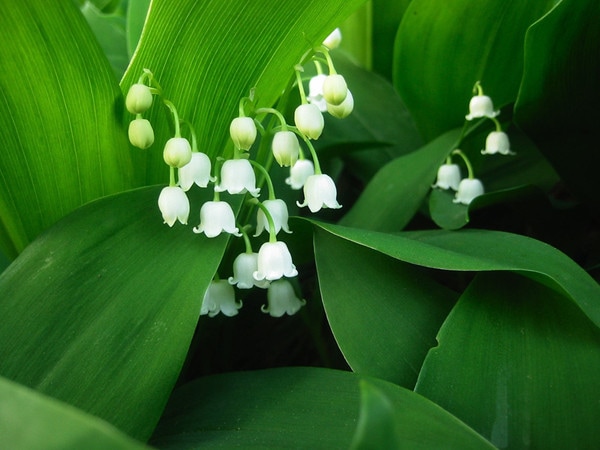|
Today, May Day, people all over France will be following Gallic tradition and giving deliciously fragrant posies of muguets des bois as love tokens.
The scent of muguet, known here as lily of the valley is a British native: the 16th-century Gerard's Herbal describes it as growing "on Hampsted Heath, four miles from London, in great abundance". The second part of the Latin name, Convallaria majalis, refers to the fact that it flowers in May. In France it appears early in the month, here a little later. Lily of the Valley is found across Europe, Asia and in North America, in dry woodland, usually on alkaline soils and sometimes in the crevices or grikes of limestone pavement. In common with many plants that are impossible to eradicate once they've made themselves at home – Reginald Farrer calls it "the worst of all delicious weeds" – it is notoriously difficult to establish. Just below the surface of the soil its stems eke out a living from the leaf litter and radiate outwards, producing tufted roots and aerial shoots at their nodes. This colonising habit, essential in its native habitat as it quests for new food sources, is also the reason for the patchy growth in a garden setting. If you leave it to wander lily of the valley should flower happily, the stem extending as the round green buds open and allow the bells to hang gracefully. In the Language of Flowers, Lily of the Valley means: Sweetness; Tears of the Virgin Mary; Return to Happiness; Humility; You've Made My Life Complete. Lily of the Valley is healing by its beauty and good intentions but is extremely toxic, it cannot be eaten or added in a tea. It is also impossible for perfumers to capture its soul. If some perfumers pretend to sell you Lily of the Valley perfume, you can always tell it is a synthetic reproduction of the smell and therefore not a natural perfume.
1 Comment
|
AuthorsAuthors are gardening and essential oils experts in a variety of categories including distillation, plants healing and cleansing properties. Archives
May 2023
Categories
All
|
- Home
- Introduction
- Choose your Plan
-
Choose your Plants
- Alecost
- Anchusa
- Angelica
- Balkan Sage
- Balm
- Basil Sweet & Bush
- Bergamot
- Borage
- Calaminth
- Camphor Plant
- Caraway
- Catmint
- Chamomile
- Chervil
- Chives
- Clary
- Comfrey
- Coriander
- Dill
- Elecampane
- Fennel
- Fennel Florence
- Feverfew
- Garlic
- Germander
- Giant Catmint
- Herb Patience
- Horehound
- Hyssop
- Lad's Love
- Lady's Maid
- Lavender
- Lily of the Valley
- Lovage
- Lungwort
- Mace
- Mallow
- Marigold
- Marjoram
- Melilot
- Mints
- Old Lady
- Parsley
- Pennyroyal
- Rose
- Rosemary
- Rue
- Sage
- Salvia Virgata Nemorosa
- Santolina Chamaecyparissus
- Savory
- Sorrel
- Sweet Cicely
- Tansy
- Tarragon
- Thyme
- Vervain
- Woad
- Wormwood
- Workshops
- Q & A
- Blog
- Contact
- Home
- Introduction
- Choose your Plan
-
Choose your Plants
- Alecost
- Anchusa
- Angelica
- Balkan Sage
- Balm
- Basil Sweet & Bush
- Bergamot
- Borage
- Calaminth
- Camphor Plant
- Caraway
- Catmint
- Chamomile
- Chervil
- Chives
- Clary
- Comfrey
- Coriander
- Dill
- Elecampane
- Fennel
- Fennel Florence
- Feverfew
- Garlic
- Germander
- Giant Catmint
- Herb Patience
- Horehound
- Hyssop
- Lad's Love
- Lady's Maid
- Lavender
- Lily of the Valley
- Lovage
- Lungwort
- Mace
- Mallow
- Marigold
- Marjoram
- Melilot
- Mints
- Old Lady
- Parsley
- Pennyroyal
- Rose
- Rosemary
- Rue
- Sage
- Salvia Virgata Nemorosa
- Santolina Chamaecyparissus
- Savory
- Sorrel
- Sweet Cicely
- Tansy
- Tarragon
- Thyme
- Vervain
- Woad
- Wormwood
- Workshops
- Q & A
- Blog
- Contact

 RSS Feed
RSS Feed

